Articles
- Page Path
- HOME > J Korean Powder Metall Inst > Volume 28(5); 2021 > Article
-
Article
10Cr-1Mo 산화물 분산강화 강의 미세조직과 인장특성에 미치는 기계적 합금화 공정시간의 영향 - 노상훈a,*, 김태규b
- Evolution on Microstructures and Tensile Properties of 10Cr-1Mo ODS Steel with Different Lengths of Mechanical Alloying Process Times
- Sanghoon Noha,*, Tae Kyu Kimb
-
Journal of Korean Powder Metallurgy Institute 2021;28(5):375-380.
DOI: https://doi.org/10.4150/KPMI.2021.28.5.375
Published online: September 30, 2021
a 부경대학교 재료공학과
b 한국원자력연구원 재료안전기술개발부
a Department of Materials Science and Engineering, Pukyong National University, Busan 48513, Republic of Korea
b Nuclear Materials Division, Korea Atomic Energy Research Institute, Daejeon 34057, Republic of Korea
- *Corresponding Author: Sanghoon Noh, TEL: +82-51-629-6359, FAX: +82-51-629-6353, E-mail: nohssang@pknu.ac.kr
- - 노상훈: 교수, 김태규: 책임연구원
• Received: August 12, 2021 • Revised: August 29, 2021 • Accepted: August 31, 2021
© The Korean Powder Metallurgy Institute. All rights reserved.
- 808 Views
- 6 Download
Abstract
- In this study, we investigate the effect of the duration of mechanical alloying on the microstructures and mechanical properties of ODS ferritic/martensitic steel. The Fe(bal.)-10Cr-1Mo pre-alloyed powder and Y2O3 powder are mechanically alloyed for the different mechanical alloying duration (0 to 40 h) and then constantly fabricated using a uniaxial hot pressing process. Upon increasing the mechanical alloying time, the average powder diameter and crystallite size increased dramatically. In the initial stages within 5 h of mechanical alloying, inhomogeneous grain morphology is observed along with coarsened carbide and oxide distributions; thus, precipitate phases are temporarily observed between the two powders because of insufficient collision energy to get fragmented. After 40 h of the MA process, however, fine martensitic grains and uniformly distributed oxide particles are observed. This led to a favorable tensile strength and elongation at room temperature and 650°C.
- Oxide dispersion strengthened (ODS) alloy is one of the most promising structural materials because of excellent creep, irradiation and corrosion resistances for next generation nuclear systems such as a Gen. IV fission and DEMO fusion reactors [1, 2]. These are due to a featured microstructural combination between fine grains and uniformly distributed nano-oxide particles with a high density which is extremely stable at the high temperature in Fe and Ni based alloy matrices [1-3]. These unique microstructures can be obtained through the solidstate fabrication processes including mechanical alloying (MA) and hot consolidation. Mechanical alloying (MA) is an essential process in that the continuous collision between the hardened steel balls and raw powders with a high revolving and impacting energy makes the repeated crushes and cold welding of powders, which eventually creates the homogenous mixing and alloying between heterogeneous materials. MA involves optimization of some variables to achieve the unique microstructures and mechanical properties of ODS alloys. Especially, these variables should be carefully controlled to improve the mechanical property of ODS alloys at elevated tempera-ture. The time of MA is the most important parameter. In this study, effect on microstructures and mechanical properties of the 10Cr-1Mo ODS steel with different length of mechanical alloying times was investigated. Microstructural and tensile property evolutions as well as powder properties were examined to determine the optimized condition of the fabrication process.
1. Introduction
- The ODS steels used in this study is Fe(bal.)-10Cr- 1Mo-0.35Y2O3 (in wt.%) with some minor alloying elements containing Ni, Ti, and Zr. Mother alloy ingots without Y2O3 were prepared by a vacuum induction melting process. Homogenization heat treatment at 1250°C for 2 h was followed. Mother alloy powders were then fabricated by Ar gas atomization process at 1700°C with as gas pressure of 70 bar. The chemical composition of the mother alloy ingot and powder was summarized in Table 1.
- The ODS steel was fabricated by MA and uniaxial hot pressing (UHP) processes. The pre-alloyed powders and Y2O3 powder were mechanically alloyed by a high energy horizontal ball-mill apparatus, Simoloyer CM20 with hardened steel balls. To investigate the effects of the MA time, powders were mechanically alloyed for various times, to 40 h. A pre-mixed powder consisted with same constitution elements was also employed to compare with pre-alloyed powders. After the MA process, characterization of powder properties including surface morphology, particle size and crystalline phase were carried out. Particle size distribution was measured using a laser diffraction scattering method with a particle size analyzer. A field-emission scanning electron microscope (FE-SEM) was utilized to observe the surface morphology of the powders. The crystalline phase was evaluated by X-ray diffraction (XRD) analysis. Powders with different MA times were then consolidated using a UHP at 1150°C for 2 h. The process was performed in a high vacuum under a hydrostatic pressure of 80 MPa in a uni-axial compressive loading mode. After the process, the pressure was relieved and samples were cooled in the furnace. Normalizing and tempering heat treatments was also done at 1150°C for 60 min and at 750°C for 30 min, respectively. The microstructures were observed by FE-SEM and transmission electron microscopes (TEM). Specimens for mechanical property evaluations were taken out by the electro-discharge machining. A miniaturized sheet-type tensile specimen whose gauge length was 5 mm, width was 1.2 mm, and thickness 0.5 mm was used. These are developed for the irradiation study for nuclear/fusion structural material as a small specimen test technology (SSTT), since the irradiation volume is efficiently limited and the reduction of high radiation activity was required for post-irradiation experiment (PIE) [4]. Tensile tests were carried out at room temperature and 650°C in air at a strain rate of 10-4 s-1. Total elongations were estimated using gauge length changes during the tensile tests.
2. Experimental
- 3.1 Evolution of powder properties and microstructures with different length of mechanical alloying times
- The surface morphologies of mechanically alloyed powder with different length of MA times were shown in Fig. 1. For a pre-alloyed powder, initial raw metallic powders were quite spherical shape because the powders were manufactured by high pressure Ar-gas atomization process. After 1 h for the mechanical alloying process, both powders showed irregularly spherical and flake shape with rough surface. As increase the milling time, a particle size was decreased with somewhat uniform flake shape in both pre-mixed and pre-alloyed powders. The change of mean particle size with different length of MA time was plotted in Fig. 2. The particle size was dramatically increased in the initial stage of the MA process and this means that the cold-welding and agglomeration were more dominant than the pulverization by milling media. After 10h of MA, however, continuous cold-welding and pulverization occurred repeatedly because the mean particle size was decreased slightly, as milling time increased. Change of particle size in pre-alloyed powder was stabilized after 25 h. After 40 h, however, decrease of particle size in pre-mixed powder was continued, this means that more mechanical alloying time is needed. The evolution of XRD patterns with different mechanical alloying times was shown in Fig. 3. Before the MA process, a quite weak Y2O3 peak was identified in both MA powders, and several main diffraction peaks were also identified as bcc Fe and Cr. However, Y2O3 peaks completely disappeared even after the mechanical alloying for 1 h. The intensity of diffraction peaks decreased with increasing the mechanical alloying times. In Fig. 4, the crystallite size with different length of MA time was shown. Crystallite size of bcc iron can be estimated using the Scherrer equation [5]:
- where λ is X-ray wave length (=1.54 Å), β is the true full width at the half maximum height (FWHM) and θ is diffraction angle of Fe, Cr(110) peaks in Fig. 3. Evolutions of crystallite size between both powders were not so different. Crystallite sizes of both powders were sharply declined in the initial stage of MA process and finally saturated after 5 h.
- After the mechanical alloying process, ODS steels can be fabricated by various consolidation processes such as hot isostatic pressing and hot extrusion. In this study, a UHP was employed to fabricate the ODS steel samples constantly. The microstructures of a pre-alloyed ingot and UHP fabricated ODS steels with various MA times were shown in Fig. 4. They are back-scattered electron images by a FE-SEM and thus, grain morphology and coarsened precipitate distributions could be clearly observed. Microstructure of a pre-alloyed ingot shows a typical tempered martensite with prior austenite grains and fine lath structures. This is a representative microstructure which is shown in high Cr heat-resistant ferritic/martensitic steels. They usually have carbides, M23C6 (M=Cr, Fe, W, Mo), which were clearly observed as many white dots in several tens of nm on the grain boundaries. After 2h MA, inhomogeneous grain morphology was observed as well as coarse carbides distribution. Black dots were also observed, which are oxides such as Y2O3 and TiO2. Abnormal grain growth could be partially observed after 5 h MA. These mean that sufficient mechanical alloying could not be achieved within 5 h MA, thus precipitate phases are temporarily located between powder and powder, this eventually resulted that inhomogeneous grains and coarse precipitates are distributed due to insufficient collision energy between hardened steel balls to get fragmented the strengthening phases. Quite homogenous distribution of fine grains and precipitates was observed after 25-40 h MA. More detailed TEM observations were carried out and the results were shown in Fig 5. Precipitates in the ingot were 100~200 nm of carbides, which are located in grains and grain boundaries. In an ODS steel with 5 h MA, fine and coarse oxide particles were co-existed. This could be coincided with a result of FESEM observation. After 40 h MA, however, extremely fine and uniform distribution of nano-oxide particles could be clearly observed in micro-grain matrix. Oxide particles after 40 h MA were significantly reduced below 10 nm. These fine oxide particles are Y2Ti2O7 or Y2TiO5 complex oxides, which is well known that the Y-Ti-O complex oxides are formed by a combination of Y2O3 and TiO2 in Ti added ODS steels [6]. As a result, fine and homogeneous grain distribution can be fabricated with 40h MA and the hot consolidation process, which is attributed to the suppression of grain boundary migration and grain growth by uniformly distributed nano-oxide particle and this is called as the pinning effect [7].
- 3.2 Evolution of tensile properties with different length of mechanical alloying times
- The results on tensile properties of the 10Cr-1Mo ODS steel as a function of various mechanical alloying time were summarized in Fig. 6. As increase the mechanical alloying time, ultimate tensile strength (UTS) of the ODS steel was dramatically increased with the decrease of total elongation at a room temperature. The tensile strengths of ODS steels with initial stage of mechanical alloying process were significantly poor, while favorable tensile strength over 1 GPa were evaluated after 10 h MA. In the initial stage of MA, strengthening phases such as Y2O3 and TiO2 were not sufficiently distributed as results of microstructure observations. This means more collision energy should be employed to distribute the strengthening phases in Fe-Cr alloy matrix. This behavior was also well presented in a result of tensile properties at elevated temperature, 650°C as shown in Fig. 6(b). Generally, conventional ferrttic/martensitic steels with fine and uniform tempered martensitic grains and carbide precipitates show favorable tensile properties below 600°C. However, significantly poor tensile strength without a MA process at 650°C. The UTS of ODS steel after 40 h exhibited 1217, 475 MPa with a sufficient total elongation (TE) of 11.4, 22.5% at 25, 650°C, respectively. The existence of uniformly distributed second phases such as nano-scaled oxide particles in Fe-Cr alloy matrix is extremely sufficient to improve the mechanical properties at elevated temperatures. In this study, however, sufficiently long periods of mechanical alloying time at least tens of hours were inevitable to fabricate favorable microstructure with fine tempered martensitic grains and homogeneously distributed nano-sized oxide particles.
3. Results and discussion
Fig. 1
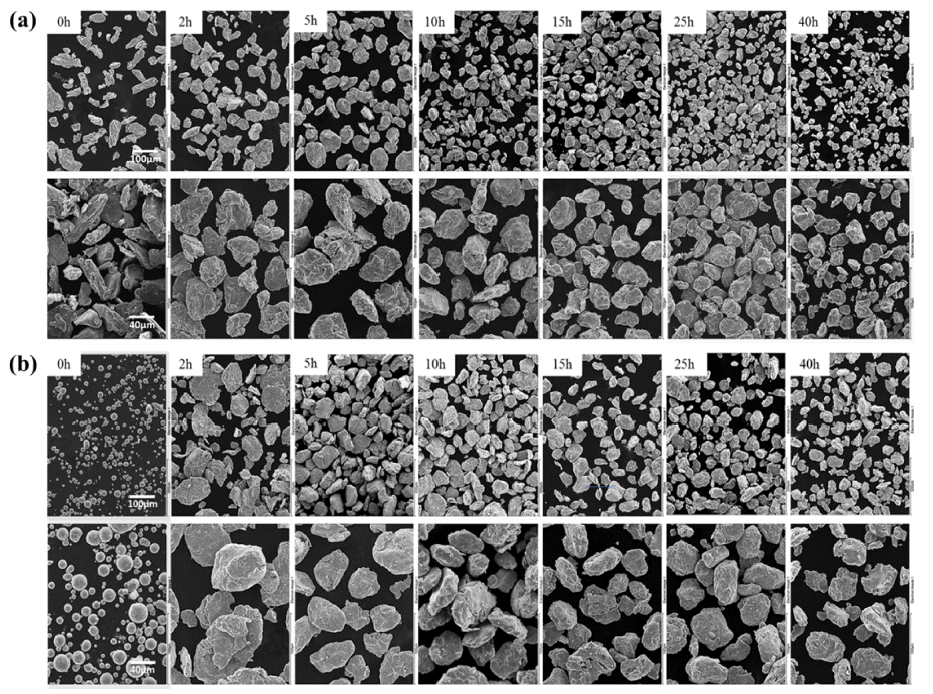
Surface morphologies of mechanically alloyed powder with different length of MA times; (a) pre-mixed powder, (b) prealloyed powder.

Fig. 3
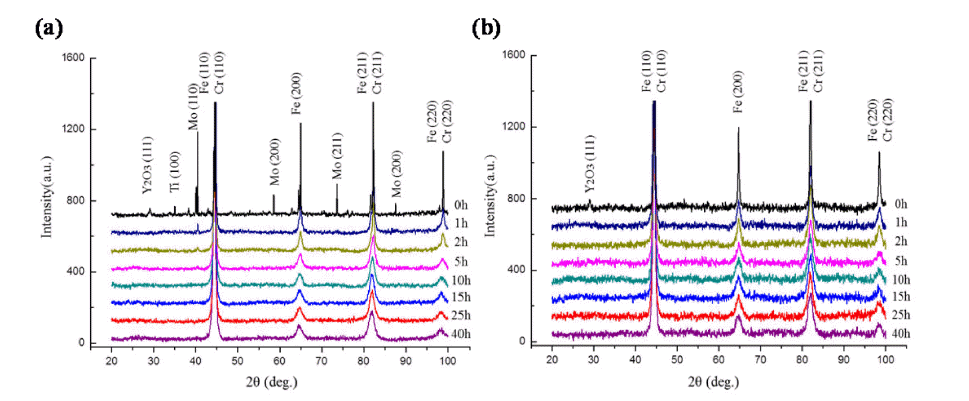
XRD patterns of MA powders with different length of MA time; (a) pre-mixed powder, (b) pre-alloyed powder.

Fig 5
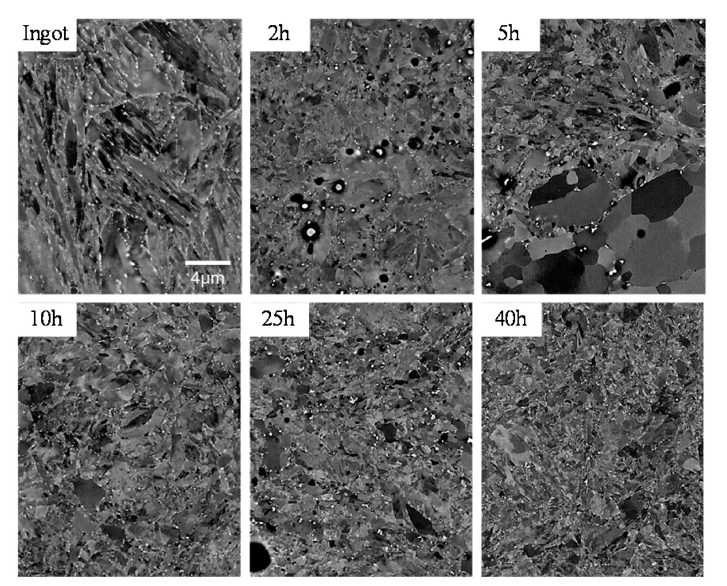
FE-SEM images of microstructures of a pre-alloyed ingot and UHP fabricated ODS steels with different length of mechanical alloying times.

- In this study, evolutions on powder properties, microstructures, and tensile properties of the 10Cr-1Mo ODS steel with different length of mechanical alloying times were investigated. As increase the mechanical alloying time, a mean particle diameter was decreased with somewhat uniform flake shape. Crystallite size of mechanically alloyed powders was sharply declined in the initial stage of MA process and finally saturated after 5 h. Abnormal growth grains and coarsened precipitates were partially observed after 5-10 h MA processes. In the longer length of MA time, however, fine and homogeneous grains and nano-scaled oxide particle distributions could be fabricated with 40 h MA and the hot consolidation process. This led to the favorable tensile strength and elongation at a room temperature and 650°C. This was attributed to sufficiently long periods of mechanical alloying time at least tens of hours for a 10Cr-1Mo ODS steel.
4. Conclusions
- 1. T. K. Kim, S. Noh, S. H. Kang, J. J. Park, H. J. Jin, M. K. Lee, J. Jang and C. K. Rhee: Nucl. Eng. Technol., 48 (2016) 572..Article
- 2. S. Ukai, T. Okuda, M. Fujiwara, T. Kobayashi, S. Mizuta and H. Nakashima: J. Nucl. Sci. Technol., 39 (2002) 872..Article
- 3. C. W. Park, J. M. Byun, J. K. Park and Y. D. Kim: J. Korean Powder Metall. Inst., 23 (2016) 61..Article
- 4. Y. Kohno, A. Kohyama, M. L. Hamilton, T. Hirose, Y. Katoh and F. A. Garner: J. Nucl. Mater., 283-287 (2000) 1014..Article
- 5. C. Suryanarayana: Prog. Mater Sci., 46 (2001) 53. .Article
- 6. S. Ukai, T. Nishida, H. Okada, T. Okuda, M. Fujiwara and K. Asabe: J. Nucl. Sci. Technol., 34 (1997) 256..Article
- 7. R. Gao, T. Zhang, X. P. Wang, Q. F. Fang and C. S. Liu: J. Nucl. Mater., 444 (2014) 462..Article
Figure & Data
References
Citations
Citations to this article as recorded by 

 ePub Link
ePub Link-
 Cite this Article
Cite this Article
- Cite this Article
-
- Close
- Download Citation
- Close
- Figure
- Related articles
-
- Effect of the Cross-rolling Process on the Microstructures and Mechanical Properties of 9Cr-1W ODS Steel
- Microstructures and Mechanical Properties of Al-B4C Composites Fabricated by DED Process
- Effect of Substrate Pre-heating on Microstructure and Magnetic Properties of Nd-Fe-B Permanent Magnet Manufactured by L-PBF
- Evaluation of Microstructures and Mechanical Properties of Ni-Y2O3 Sintered Alloys Based on the Powder Preparation Methods
- Effect of Heat Treatment on Microstructure and Mechanical Properties of Al–Zn–Mg–Cu–Si Sintered Alloys with and Without High-energy Ball Milling
Evolution on Microstructures and Tensile Properties of 10Cr-1Mo ODS Steel with Different Lengths of Mechanical Alloying Process Times

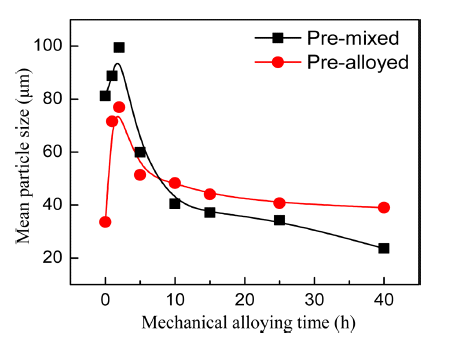

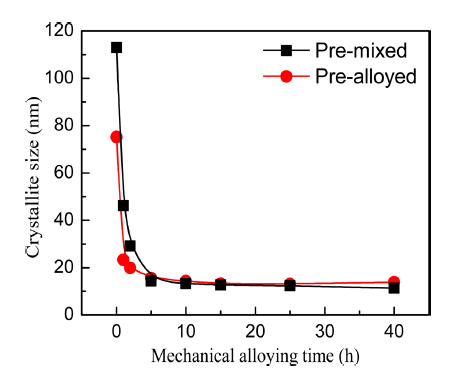


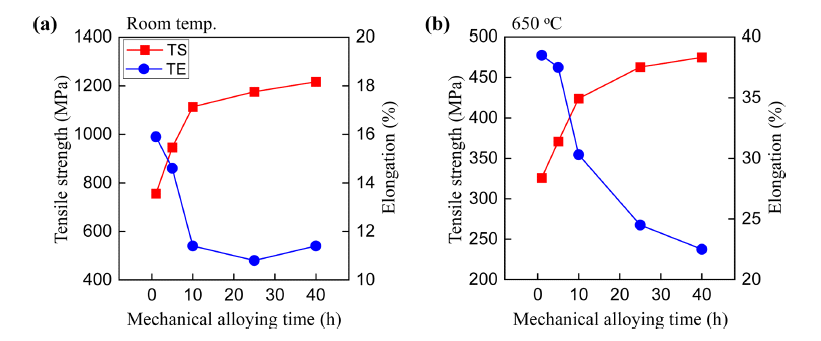
Fig. 1
Surface morphologies of mechanically alloyed powder with different length of MA times; (a) pre-mixed powder, (b) prealloyed powder.
Fig. 2
Mean particle sizes with different length of MA times.
Fig. 3
XRD patterns of MA powders with different length of MA time; (a) pre-mixed powder, (b) pre-alloyed powder.
Fig. 4
Crystallite sizes with different length of MA times.
Fig 5
FE-SEM images of microstructures of a pre-alloyed ingot and UHP fabricated ODS steels with different length of mechanical alloying times.
Fig. 6
Bright field TEM images of microstructures of a pre-alloyed ingot and UHP fabricated ODS steels with different length of mechanical alloying times.
Fig. 7
Tensile properties of UHP fabricated ODS steels with different length of mechanical alloying times; at (a) a room temperature, (b) 650°C.
Fig. 1
Fig. 2
Fig. 3
Fig. 4
Fig 5
Fig. 6
Fig. 7
Evolution on Microstructures and Tensile Properties of 10Cr-1Mo ODS Steel with Different Lengths of Mechanical Alloying Process Times
Table 1
Chemical composition of pre-alloyed powder
Table 1
TOP
 KPMI
KPMI














